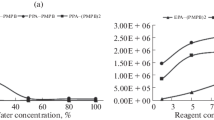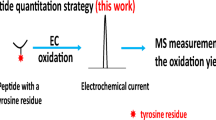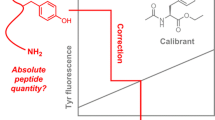Abstract
A highly selective sequential derivatization sequence has been developed for the transformation of 3-nitrotyrosine to a 2-anilino-benzoxazole derivative. This sequence can be applied to any ortho-nitrophenol, such as 3-nitrotyrosine or 3-nitrotyrosine residues present in proteins and/or peptides as a result of oxidative stress. The sequence involves a standard reduction of the nitro functional group to the corresponding amine using aqueous dithionite, followed by aqueous solution coupling with phenylisothiocyanate (PITC) and then eventual product formation by a photochemical mediated intramolecular cyclization of the intermediate thiourea. While this cyclization step has been effected numerous times by various reagents commonly used in synthetic organic chemistry, many requiring non-aqueous reaction media, the present transformation appears to the be first description this reaction using 350 nm light in aqueous media. The resulting overall transformation provides a specific mass shift signature of 116 amu when conducted with 1H5-PITC and 121 amu with 2H5-PITC, thus forming the basis of relative quantitation by MS detection. In preliminary experiments, relative quantitation was accomplished for the decapeptide angiotensin I that had been subjected to nitration.





Similar content being viewed by others
References
Davies MJ (2005) Biochim Biophys Acta 1703:93–109
Radi R (2004) Proc Natl Acad Sci USA 101:4003–4008. doi:10.1073/pnas.0307446101
Greenacre SAB, Ischiropoulos H (2000) Free Radic Res 34:541–581. doi:10.1080/10715760100300471
Sachsterder CA, Qian WJ, Knyushko TV, Wang H, Chin MH, Lacan G et al (2006) Biochemistry 45:8009–8022. doi:10.1021/bi060474w
Leeuwenburgh C, Hardy MM, Hazen SL, Wagner P, Oh-Ishi S, Steibrecher UP et al (1997) J Biol Chem 272:1433–1436. doi:10.1074/jbc.272.3.1433
Ambs S, Merriam WG, Bennet WP, Pelley-Bosco E, Ogunfusika MO, Oser SM et al (1998) Cancer Res 58:334–341
Aslan M, Ozben T (2004) Curr Alzheimer Res 1:111–119. doi:10.2174/1567205043332162
Butterfield DA (2004) Brain Res 1000:1–7. doi:10.1016/j.brainres.2003.12.012
Drew B, Leeuwenburgh C (2002) Ann N Y Acad Sci 959:66–81
Ischiropoulos H (2003) Biochem Biophys Res Commun 305:776–783. doi:10.1016/S0006-291X(03)00814-3
Quint P, Reutzel R, Mikulski R, McKenna R, Silverman DN (2006) Free Radic Biol Med 40:625–631. doi:10.1016/j.freeradbiomed.2005.08.045
Park S, Huq MD, Hu X, Wei LN (2005) Mol Cell Proteomics 4:300–309. doi:10.1074/mcp.M400195-MCP200
Sahoo R, Dutta T, Das A, Sinha RS, Sengupta R, Ghosh S (2006) Free Radic Biol Med 40:625–631. doi:10.1016/j.freeradbiomed.2005.09.029
Zheng L, Nukuna B, Brennan ML, Sun M, Goormastic M, Settle M et al (2004) J Clin Invest 114:529–541
Xu S, Ying J, Jiang B, Guo W, Adachi T, Sharov V et al (2006) Am J Physiol Heart Circ Physiol 290:H2220–H2227. doi:10.1152/ajpheart.01293.2005
Phung AD, Soucek K, Kubala L, Harper RW, Chlo-Bulinski J, Eiserich JP (2006) Eur J Cell Biol 85:1241–1252. doi:10.1016/j.ejcb.2006.05.016
Dalle-Donne I, Scaloni A, Gliustarini D, Cavarra E, Tell G, Lungarella G et al (2005) Mass Spectrom Rev 24:55–99. doi:10.1002/mas.20006
Davies MJ, Fu S, Wang H, Dean RT (1999) Free Radical Med Biol 27:1151–1163
Beal MF (2002) Free Radic Biol Med 32:797–803. doi:10.1016/S0891-5849(02)00780-3
Crow JP (1999) Methods Enzymol 301:151–160
Kamisaki Y, Wada K, Nakamoto K, Kishimoto Y, Kitaqno M, Itoh T (1996) J Chromatogr B Analyt Technol Biomed Life Sci 685:343–347. doi:10.1016/S0378-4347(96)00202-2
Yang Q, Zhang XL, Ma M, Huang KJ, Zhang JX, Ni WZ et al (2007) J Chromatogr A 1146:23–31. doi:10.1016/j.chroma.2007.01.077
Duncan MW (2003) Amino Acids 25:351–361. doi:10.1007/s00726-003-0022-z
Tsikas D, Caidahl K (2005) J Chromatogr B Analyt Technol Biomed Life Sci 814:1–9. doi:10.1016/j.jchromb.2004.10.003
Kanski J, Alterman MA, Schöneich C (2003) Free Radic Biol Med 35:1229–1239. doi:10.1016/S0891-5849(03)00500-8
Kanski J, Behring A, Pelling J, Schöneich C (2005) Am J Physiol Heart Circ Physiol 288:H371–H381. doi:10.1152/ajpheart.01030.2003
Kanski J, Schöneich C (2005) Methods Enzymol 396:160–171. doi:10.1016/S0076-6879(05)96016-3
Nikov G, Bhat V, Wishnok JS, Tannenbaum SR (2003) Anal Biochem 320:214–222. doi:10.1016/S0003-2697(03)00359-2
Zhang Q, Qian W-J, Knyusshko TV, Clauss RW, Purvine SO, Moore RJ et al (2007) J Proteome Res 6:2257–2268. doi:10.1021/pr0606934
Sokolovsky M, Riordan JF, VAllee BL (1967) Biochem Biophys Res Commun 27:20–25. doi:10.1016/S0006-291X(67)80033-0
Omar A-MME, Habib NS, Aboulwafa OM (1977) Synthesis 864–865. doi:10.1055/s-1977-24609
You S-W, Lee K-J (2001) Bull Korean Chem Soc 22:1270–1272
Chang HS, Yon GH, Kim YH (1986) Chem Lett 5:1291–1294. doi:10.1246/cl.1986.1291
Ogura H, Mineo S, Nakagawa K (1981) Chem Pharm Bull (Tokyo) 29:1518–1524
Qian X, Li Z, Song G, Li Z (2001) J Chem Res (S) 138–139
Yoon JH, Song H, Kim SW, Han G, Choo H-YP (2005) Heterocycles 65:2729–2740
Ishida J, Yamaguchi M, Nakamura M (1991) Analyst (Lond) 116:301–304. doi:10.1039/an9911600301
Nohta H, Yukizawa T, Ohkura Y, Yoshimura M, Ishida J, Yamaguchi M (1997) Anal Chim Acta 344:233–240. doi:10.1016/S0003-2670(96)00614-9
Tarr GE (1988) Manual methods for protein/peptide sequence analysis. In: Bhown AS (ed) Protein/peptide sequence analysis: current methodologies. CRC Press, Boca Raton, pp 35–47
Sims P (1959) J Chem Soc 3648–3649
Varma RS, Kumar D (1998) J Heterocycl Chem 35:1539–1540
Tauer E, Grellman KH (1981) J Org Chem 46:4252–4258. doi:10.1021/jo00334a029
Zhang R, Sioma CS, Wang S, Regnier FE (2001) Anal Chem 73:5142–5149. doi:10.1021/ac010583a
Zhang R, Sioma CS, Thomspon RA, Xiong L, Regnier FE (2002) Anal Chem 74:3662–3669. doi:10.1021/ac025614w
Riordan JF, Sokolovsky M, Valee BL (1966) Biochemistry 5:3582–3589. doi:10.1021/bi00875a029
Acknowledgment
This research was supported by NIH grants AG25350 and AG23551.
Author information
Authors and Affiliations
Corresponding author
Additional information
Leon van Haandel and Jacque Killmer contributed equally to this work.
Rights and permissions
About this article
Cite this article
van Haandel, L., Killmer, J., Li, X. et al. Phenylisothiocyanate as a Multiple Chemical Dimension Reagent for the Relative Quantitation of Protein Nitrotyrosine. Chroma 68, 507–516 (2008). https://doi.org/10.1365/s10337-008-0761-9
Received:
Accepted:
Published:
Issue Date:
DOI: https://doi.org/10.1365/s10337-008-0761-9




